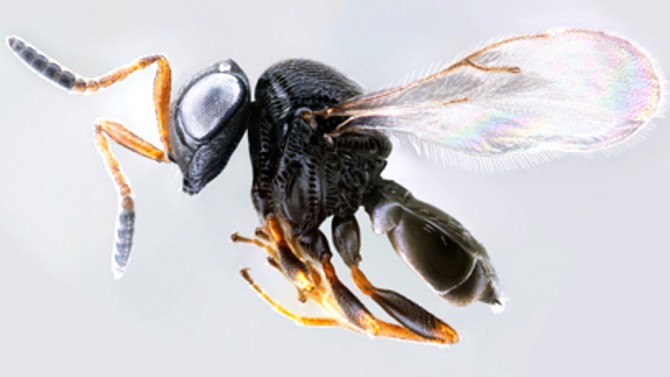Scientists sic samurai wasps on stink bugs
By Krishna Ramanujan
“Samurai Wasps vs. Stink Bugs” is not the title of the latest Avengers film. But it does describe new efforts by Cornell scientists to control a household nuisance and agricultural pest.
The flat-bodied, thin-legged brown marmorated stink bugs invade homes in the winter and infest crops in the summer, in particular apples, sweet corn and stone fruits such as peaches, cherries, plums, nectarines and apricots.
Native to Asia, brown marmorated stink bugs (Halyomorpha halys) were first detected in Pennsylvania in the 1990s before spreading up the East Coast. In 2010, the right environmental conditions caused their numbers to skyrocket. Every four or five years in New York state, stink bugs will hatch two generations in a single year, one in the spring and another in August, which leads to exponential population growth.
“By 2012, we saw a 20 to 30 percent loss in apple production from the damage caused by brown marmorated stink bugs” in Dutchess and Orange counties, said Peter Jentsch, a senior extension associate and director of the Hudson Valley Research Laboratory in Highland, New York.
Samurai wasps (Trissolcus japonicus), native to Asia, are now found in many parts of the United States. The wasps lay their eggs inside the brown marmorated stink bugs’ eggs, killing developing nymphs and hatching as adult wasps.
“As a biocontrol agent, the wasp is not only very effective at reducing the population of brown marmorated stink bugs, but [it is] the least environmentally damaging of all the options for controlling this pest in both the urban and agricultural system,” Jentsch said.
Last year, Cornell researchers trapped wild samurai wasps in Marlboro, New York, and reared new colonies. They then released the wasps as a biocontrol agent on 24 farms in 32 agricultural sites throughout New York in Orange, Ulster, Dutchess, Columbia, Wayne, Ontario, Orleans and Monroe counties. They also placed stink bug eggs around the perimeter of orchards and vegetable fields to see if the wasps would parasitize them.
Initial findings revealed 70 percent of the wasps survived after release across the sites surveyed, and wasps parasitized the eggs placed by the researchers in two of the sites. This year, the scientists will determine how well wasp populations survived the winter; the researchers will assess the wasp’s ability to control brown marmorated stink bugs in New York in the years to come.
In addition, researchers are in the process of investigating “attract and kill” stations for homeowners and growers to tackle stink bugs, using a pheromone to attract the bugs to netting embedded with pyrethroid insecticide, which kills them.
Jentsch has been working with Art Agnello, professor of entomology at the New York State Agricultural Experiment Station in Geneva, New York, and Cornell Cooperative Extension specialists to create a statewide, county-based map that shows presence and distribution of brown marmorated stink bugs. Using an invasive mapping system, the researchers set traps to see where the stink bugs have passed a threshold of 10 adult insects per trap. The system incorporates those data to create a color-coded map of the presence of brown marmorated stink bugs within each county.
The data also contribute to national stink bug tracking efforts, funded by the United States Department of Agriculture’s Specialty Crop Research Initiative.
“We are trying to generate information of a national as well as a statewide presence in New York,” Jentsch said.
A Jentsch Lab blog site also links to a brown marmorated stink bug identification page so users can correctly identify the insect before treating their crops.
Media Contact
Get Cornell news delivered right to your inbox.
Subscribe


